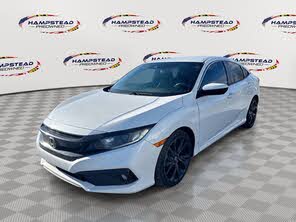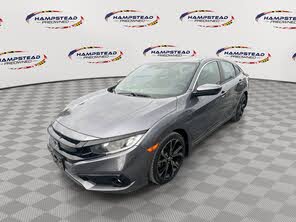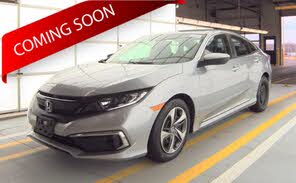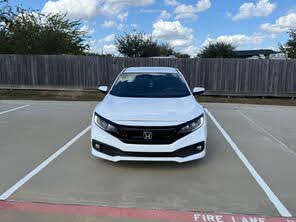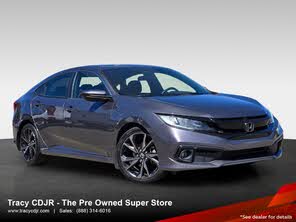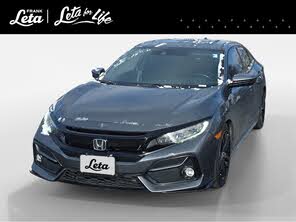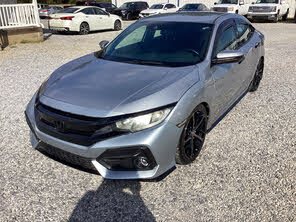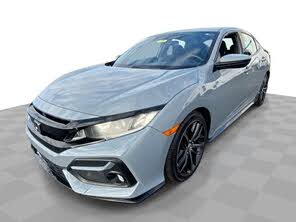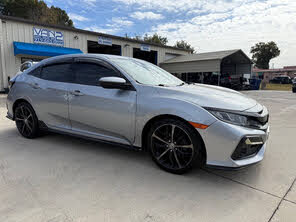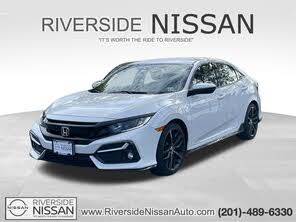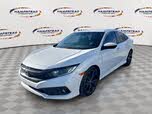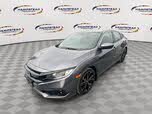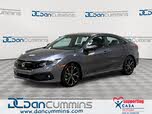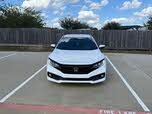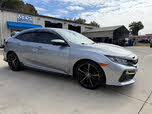2020 Honda Civic vs 2020 Honda Civic Hatchback
Overview | |
MSRP$21,750 | MSRP$20,000 |
Listings388 | Listings1577 |
Ratings & Reviews | |
User Reviews | User Reviews |
Expert reviews7.7 out of 10 | Expert reviews8.2 out of 10 |
Pros
Cons
| Pros
Cons
|
2020 Honda Civic Hatchback Reviews SummaryWhen the Honda Civic first went on sale in the US in 1973, it was a tiny 3-door hatchback capitalizing on concerns arising out of the OPEC Oil Embargo. In other words, it was a safe and smart choice during a period of unrest and uncertainty. Eventually though, years after oil pipelines once again gushed with plentiful crude, hatchbacks became synonymous with economic despair. Judgmental types assumed you couldn’t afford anything better, and soon few people wanted them anymore. Today, hatchbacks are making comebacks, and the 2020 Honda Civic Hatchback is a good example of why. | |
2020 Honda Civic Reviews SummaryMinor design tweaks, more standard safety and convenience features, and more manual transmissions arrive as the standout changes for the Civic's 2020 model year. Last redesigned for the 2016 model year, the Civic keeps outperforming its small-car peers by offering the performance and quality of more expensive cars, while retaining the value and longevity expected of a Honda. Plus, I had a really fun week with the turbocharged Civic Si. | |
Popular Features & Specs | |
Engine1.5L 174 hp I4 | Engine2.0L 158 hp I4 |
Drive TrainFWD | Drive TrainFWD |
Seating Capacity5 | Seating Capacity5 |
Horsepower174 hp @ 6000 rpm | Horsepower158 hp @ 6500 rpm |
MPG City31 | MPG City25 |
MPG Highway40 | MPG Highway36 |
Engine | |
Engine Name1.5L 174 hp I4 | Engine Name2.0L 158 hp I4 |
Torque162 lb-ft @ 1700 rpm | Torque138 lb-ft @ 4200 rpm |
Horsepower174 hp @ 6000 rpm | Horsepower158 hp @ 6500 rpm |
DrivetrainFWD | DrivetrainFWD |
Fuel Economy | |
MPG City31 | MPG City25 |
MPG Highway40 | MPG Highway36 |
Interior | |
Seating Capacity5 | Seating Capacity5 |
Safety | |
Front Crash Overall5 | Front Crash Overall5 |
Side Crash Overall5 | Side Crash Overall5 |
Dimensions & Capacity | |
Cargo Space25.7 cu ft | Cargo Space15.1 cu ft |
Curb Weight2906 lbs | Curb Weight2762 lbs |
Height56.5 in | Height55.7 in |
Length177.9 in | Length182.7 in |
Width70.8 in | Width70.8 in |
Wheelbase106.3 in | Wheelbase106.3 in |
Maximum Payload | Maximum Payload1007 lbs |
Number of doors4 | Number of doors4 |
Overview | ||
MSRP | $21,750 | $20,000 |
Listings | ||
Ratings & Reviews | ||
User reviews | ||
Expert reviews | 7.7 out of 10Read full review | 8.2 out of 10Read full review |
Pros & cons | Pros
Cons
| Pros
Cons
|
Summary | When the Honda Civic first went on sale in the US in 1973, it was a tiny 3-door hatchback capitalizing on concerns arising out of the OPEC Oil Embargo. In other words, it was a safe and smart choice during a period of unrest and uncertainty. Eventually though, years after oil pipelines once again gushed with plentiful crude, hatchbacks became synonymous with economic despair. Judgmental types assumed you couldn’t afford anything better, and soon few people wanted them anymore. Today, hatchbacks are making comebacks, and the 2020 Honda Civic Hatchback is a good example of why. | Minor design tweaks, more standard safety and convenience features, and more manual transmissions arrive as the standout changes for the Civic's 2020 model year. Last redesigned for the 2016 model year, the Civic keeps outperforming its small-car peers by offering the performance and quality of more expensive cars, while retaining the value and longevity expected of a Honda. Plus, I had a really fun week with the turbocharged Civic Si. |
Video | ||
Popular Features & Specs | ||
Engine | 1.5L 174 hp I4 | 2.0L 158 hp I4 |
Drive Train | FWD | FWD |
Seating Capacity | 5 | 5 |
Horsepower | 174 hp @ 6000 rpm | 158 hp @ 6500 rpm |
MPG City | 31 | 25 |
MPG Highway | 40 | 36 |
Engine | ||
Engine Name | 1.5L 174 hp I4 | 2.0L 158 hp I4 |
Torque | 162 lb-ft @ 1700 rpm | 138 lb-ft @ 4200 rpm |
Horsepower | 174 hp @ 6000 rpm | 158 hp @ 6500 rpm |
Drivetrain | FWD | FWD |
Fuel Economy | ||
MPG City | 31 | 25 |
MPG Highway | 40 | 36 |
Interior | ||
Seating Capacity | 5 | 5 |
Safety | ||
Front Crash Overall | 5 | 5 |
Side Crash Overall | 5 | 5 |
Dimensions & Capacity | ||
Cargo Space | 25.7 cu ft | 15.1 cu ft |
Curb Weight | 2906 lbs | 2762 lbs |
Height | 56.5 in | 55.7 in |
Length | 177.9 in | 182.7 in |
Width | 70.8 in | 70.8 in |
Wheelbase | 106.3 in | 106.3 in |
Maximum Payload | 1007 lbs | |
Number of doors | 4 | 4 |
Half a decade ago, Honda had redesigned the Civic to rival compact cars like the Subaru Impreza and Toyota Corolla. The refreshed design elicited differing opinions and required viewing from the right angle and in good lighting to be fully appreciated. For 2020, Honda had fine-tuned the Civic Hatchback’s styling with subtle changes. While the large, fake air intakes now sported body-color crossbars that toned down their prominence, a new grille and smoked headlights were also introduced. Fresh wheel designs made their debut as well, despite the original wheels not having any significant issues.
The test car in Sport Touring trim dazzled with Platinum White Pearl paint, creating sharp contrasts with the glossy black detailing of the vehicle. Upon arrival at a family meal, several men mistook the Civic Hatchback for a Type R, expressing audible admiration for its appearance.
Inside, the Sport Touring trim offered stitched leather on the steering wheel, soft surfaces, and generally high-quality materials, with the inevitable presence of hard plastics. The feeling of solidity when closing the door with a bank-vault-like thunk and subsequent reduction in ambient noise left a lasting impression. Equipped with a six-speed manual gearbox, previously only available with the Sport trim, the price of the test car reached $28,980, including the destination charge from the UK factory.
Despite seeming expensive at first glance, the Sport Touring trim was $8,250 cheaper than a Type R. The Civic Hatchback came in multiple trims with different price points, starting from $21,650 for the LX trim, $22,750 for the Sport trim, $24,150 for the EX, and $25,350 for the leather-lined EX-L.
The Civic was often considered the crown jewel of Honda's lineup—a $20,000 compact car that offered remarkable value and engineering excellence, akin to what buyers might expect from brands like BMW. Available in sedan, coupe, and 4-door hatchback variants, the Civic directed attention to its sharp design rather than its modest size. The sedan featured a sleek roofline similar to the coupe's, but with an elongated and elegant body. Body panel creases and wide, arcing headlights emphasized the car's low and wide stance, while large LED taillights complemented the rear.
Notably, the 2019 iterations saw upgrades to grilles, bumpers, and wheels for the standard sedan and coupe models, which carried over to 2020. The Civic Si sedan sported new matte-black 18-inch wheels, LED fog lights with gloss black trim, standard LED headlights, an updated grille, and a revamped rear bumper with more body-color and gloss-black accents, mirrored in the Si coupe. The 2020 hatchback similarly received updated bumpers and lights, and new wheel options in gray or black.
The interior was simple yet well-crafted with soft-touch rubbers and high-quality switchgear. Hard plastics were confined to lower sections of the dash and doors, featuring a fine grain. Gloss-black trim adorned the steering wheel and dash, while other visual and tactile elements added to the car’s appealing ambiance.
Interior changes for 2020 included new dash accents and sport seats in the Si, which featured red bands woven into the fabric. Though the Type R had exaggerated, anime-character-esque aesthetics, the Civic's overall exterior design was sophisticated without appearing cheap.



The 2020 Civic Hatchback, particularly in Sport and Sport Touring trims, shouldn’t have been mistaken for a more practical counterpart to the Civic Si. Different powertrain outputs and handling characteristics set these models apart. Powered by a turbocharged 1.5-liter 4-cylinder engine, the Civic Hatchback produced 174 horsepower in LX, EX, and EX-L trims, and 180 horsepower in Sport and Sport Touring trims. Torque measurements were 162 lb-ft from 1,700 to 5,500 rpm with the CVT and 177 lb-ft from 1,900 to 5,000 rpm with the six-speed manual.
This power output was more than sufficient to propel the front-wheel-drive Civic Hatchback with authority while maintaining a quiet and refined drive, though the long clutch travel and gearbox throws distinguished it from the Civic Si. While the Civic Si boasted a helical limited-slip differential for sharper cornering and higher power output, the Sport and Sport Touring trims offered a softer, more comfortable ride, with wider seats, a quieter cabin, and a less frenetic driving experience.
Nevertheless, the Civic Hatchback could still bring excitement with its ability to handle spirited drives, especially through twisty canyons. While not as stiff and composed as the Civic Si, the Hatchback offered confident and enjoyable handling.
Fuel economy was impressive, with the EPA rating the test car at 32 mpg combined. Actual testing yielded an even better 32.7 mpg, despite aggressive driving.
The 2020 Civic lineup offered four engines and two transmissions, all FWD. The base LX and Sport trims featured a 2.0-liter inline 4-cylinder engine producing 158 horsepower and 138 lb-ft of torque. The six-speed manual was standard for sedan and some coupe models, while the CVT was optional. Higher trims such as EX and above came with a CVT and a turbocharged 1.5-liter inline-4 engine making 174 horsepower and 162 lb-ft of torque. In Sport and Sport Touring hatchback trims, this engine’s output was bumped to 180 horsepower.
The 1.5-liter engine stood out for its exceptional mid-range acceleration and responsiveness. Honda engines were known for their smooth revs and quick acceleration, paired with either the manual’s tight shifter or the responsive CVT that avoided peaking at high revs. The refined powertrains lived up to Honda's stellar reputation.
The Si featured a boosted 1.5-liter engine producing 205 hp and 192 lb-ft, while the Type R was a powerhouse with 306 hp and 295 lb-ft. Both high-performance models came exclusively with a stick shift. The Si, offering adaptive dampers and a sportier ride, still remained a delightful daily driver, providing a thrilling yet balanced driving experience. Turbo lag was minimal, with the boost delivered smoothly and predictably.
For 2020, the final-drive ratio in the Si was reduced by 6%, enhancing acceleration but slightly diminishing fuel economy, which now stood at 26 mpg city, 36 mpg highway, and 30 mpg combined. Most Civic models with the CVT achieved at least 30 mpg city and 42 mpg highway.
While SUVs might have become highly popular, their higher costs, heavier builds, and lower aerodynamics compared to compact cars like the Civic Hatchback made them less appealing regarding efficiency. For equivalent money spent on a loaded Civic Hatchback Sport Touring model, the Honda HR-V could be an alternative, but the Civic Hatch offered better overall performance.
The Civic Hatchback provided 25.2 cubic feet of cargo space, slightly more than the HR-V Touring's 23.2 cubic feet. Although the HR-V offered greater maximum cargo volume (46.2 versus 57.6 cubic feet), the Civic Hatchback's superior acceleration and better fuel economy (4 extra miles per gallon) made it a preferred choice.
Admittedly, the Civic Hatchback’s low driver’s seat wasn’t as convenient to enter and exit as the HR-V, and it didn’t offer as much interior space. However, the Sport Touring’s heated leather front seats, which provided ample thigh support on the driver’s side, ensured a comfortable experience. The lack of a height adjuster for the passenger seat was a downside.
The thoughtful center console storage was a highlight, featuring a sliding armrest, tray, and cupholders. This deep, flexible storage space could even accommodate an oversized water bottle.
Rear seat comfort and legroom were surprisingly good, though the absence of air-conditioning vents and dark tinted rear glass could make passengers uncomfortable on hot days.
Upgrades from 2019 included a volume knob and better cupholders. The EX hatchback models came with an eight-way power-adjustable driver’s seat, and additional sound insulation in the floor, trunk, and wheel wells enhanced cabin quietness. Earlier touchscreen-equipped models, which relied on touch-sensitive controls, had significantly improved to more traditional, user-friendly controls.
The driver’s three-spoke steering wheel integrated controls for the central display and the instrument panel’s digital tachometer and speedometer, offering easy access to various functions. Conventional PRNDL shifter and electronic parking brake simplified the gear selection interface.
The center console, with its deep storage bin, sliding trays, and movable cupholders on rails, allowed for extensive customization. Rear seatiness was generous across sedan and coupe models, though missed air vents were noted. Heated outboard seats added a touch of luxury.
The sedan's trunk offered 15 cubic feet of cargo space, slightly less for the Touring model due to the subwoofer. The coupe provided 12 cubic feet of cargo space. The hatchback, with 26 cubic feet behind the rear seats and 46 cubic feet with them folded down, provided ample storage for various needs, although it wasn’t as capacious as the Honda CR-V.
The stylish dashboard in the Civic Hatchback featured digital instrumentation and, except for the LX trim, a 7-inch touchscreen infotainment system. The system included Bluetooth, a volume knob, Apple CarPlay, Android Auto, satellite radio, text-messaging support, a navigation system, a quick-charging USB port, and a premium 12-speaker sound system. However, it lacked a tuning knob, a larger screen, and voice recognition technology that could accurately interpret commands.
While not a tech powerhouse, the Civic Hatchback offered valuable features like standard automatic climate control and Smart Entry with Walk Away Auto Lock on most trims. The latter feature provided keyless entry and automatically locked the doors when you walked away, offering peace of mind for the forgetful.
Though the Civic’s infotainment system felt outdated, it included a 7-inch touchscreen on all models except the base LX, supporting Apple CarPlay and Android Auto. Higher trims had Garmin-based navigation with fast and accurate voice recognition. The Sport Touring hatchback included a standard garage-door opener.
New for the 2020 Civic Si was Active Sound Control, pumping fake engine sounds through the speakers—a feature easily turned off in favor of the excellent 450-watt, 10-speaker stereo. The Si also included push-button start, keyless entry, a power moonroof, and heated front seats. The standout LaneWatch system provided a live video feed of the right-side blind spot, significantly enhancing safety during lane changes.
Automatic climate control became standard across all models, with Honda Sensing included in the Si trim. Honda Sensing featured active lane centering, adaptive cruise control, and auto high beams. Leather seats were available on the EX-L sedan and hatchback, while rain-sensing wipers and LED headlights were standard on the Touring, Si, and Sport Touring trims.
Every Civic Hatchback included the Honda Sensing suite as standard, offering advanced driving-assistance and collision-avoidance features. This suite comprised forward-collision warning with automatic emergency braking, automatic high-beam headlights, lane-departure warning, lane-keeping assist, Road Departure Mitigation, and adaptive cruise control with low-speed following capability for CVT-equipped models.
Despite its comprehensive safety features, this iteration of Honda Sensing lacked some refinement, particularly with lane-keeping assist and adaptive cruise control occasionally braking without cause. The absence of a blind-spot monitoring system and rear cross-traffic alert was notable, with only the LaneWatch camera covering the right-side blind spot.
The 2020 Civic Hatchback did not earn a Top Safety Pick rating from the IIHS due to poor headlight performance, though new LED headlights in the Sport Touring trim could improve this. However, the Civic received top marks for crash-test performance.
The Honda Sensing suite in the Civic included forward collision warning, emergency forward braking, lane-keeping assist, and adaptive cruise control. Improved LED headlights in 2020 helped the Civic earn a Top Safety Pick rating from the IIHS for all body styles except the Type R. The Civic achieved the top "Good" rating in all crash tests.
The NHTSA provided the Civic with five stars in all categories except the passenger frontal crash rating on the coupe, which received four stars.
CarGurus highlights
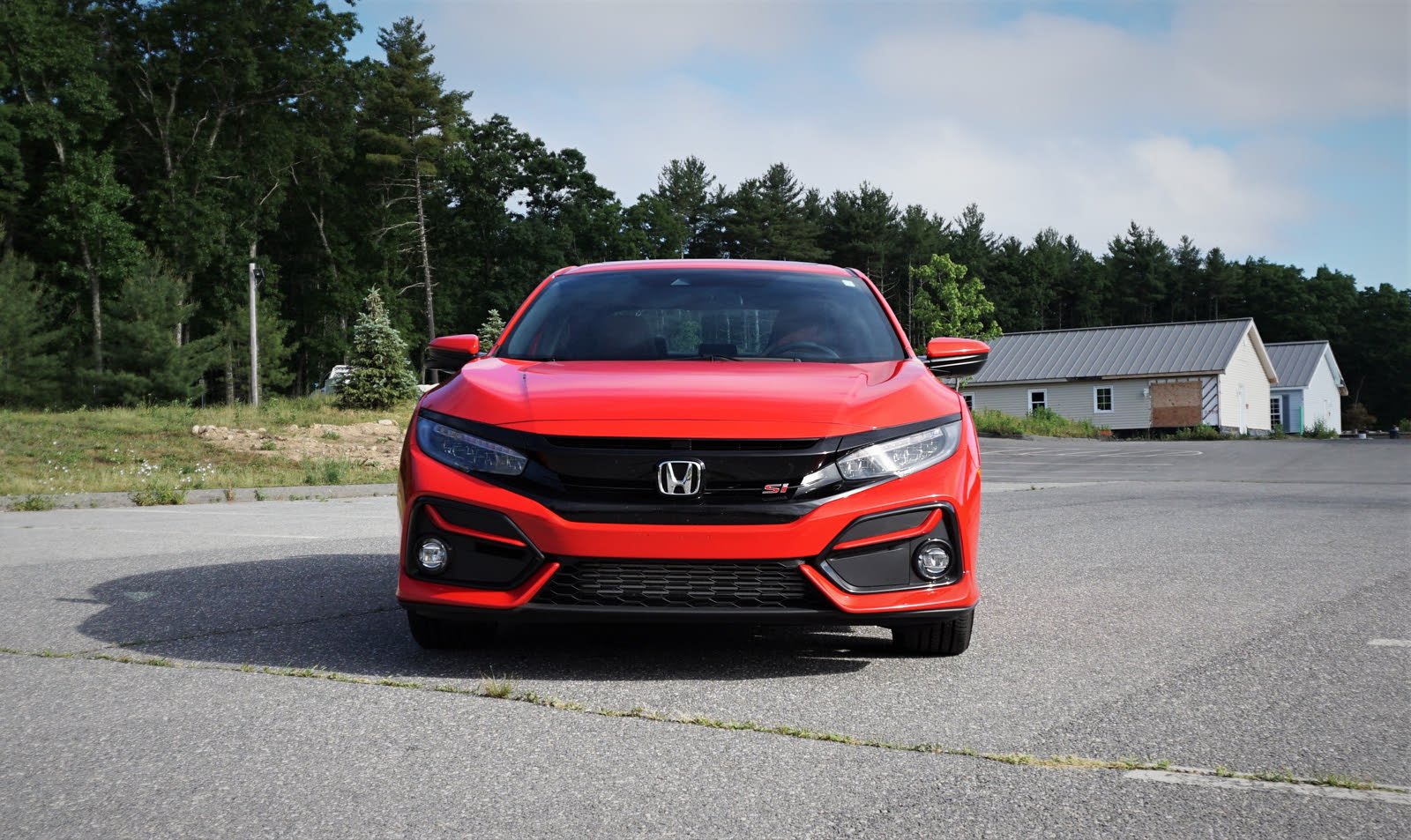
According to CarGurus experts, the overall rating for the 2020 Honda Civic Hatchback was 7.7 out of 10, while the 2020 Honda Civic scored 8.2 out of 10. Based on these ratings, the 2020 Honda Civic emerged as the better overall choice. While both vehicles offered their unique benefits, the Civic’s higher safety ratings, broader model range, and superior performance options gave it the edge. Thus, for a well-rounded and highly rated compact car, the 2020 Honda Civic was the recommended pick.
Choose the 2020 Honda Civic if:
- You desire a wider range of body styles, including sedan, coupe, and hatchback.
- You seek top-tier performance with the Si or Type R models.
- You value the highest safety ratings and comprehensive driver-assistance features.
Choose the 2020 Honda Civic Hatchback if:
- You prioritize cargo space and overall utility in a compact car.
- You prefer a more refined and comfortable everyday driving experience.
- You want a stylish yet practical vehicle with ample features at an attractive price point.
CarGurus highlights

According to CarGurus experts, the overall rating for the 2020 Honda Civic Hatchback was 7.7 out of 10, while the 2020 Honda Civic scored 8.2 out of 10. Based on these ratings, the 2020 Honda Civic emerged as the better overall choice. While both vehicles offered their unique benefits, the Civic’s higher safety ratings, broader model range, and superior performance options gave it the edge. Thus, for a well-rounded and highly rated compact car, the 2020 Honda Civic was the recommended pick.
Choose the 2020 Honda Civic if:
Shop Now- You desire a wider range of body styles, including sedan, coupe, and hatchback.
- You seek top-tier performance with the Si or Type R models.
- You value the highest safety ratings and comprehensive driver-assistance features.
Choose the 2020 Honda Civic Hatchback if:
Shop Now- You prioritize cargo space and overall utility in a compact car.
- You prefer a more refined and comfortable everyday driving experience.
- You want a stylish yet practical vehicle with ample features at an attractive price point.

By: CarGurus + AI
At CarGurus, our team of experienced automotive writers remain at the heart of our content operation, conducting hands-on car tests and writing insightful guides that are backed by years of industry experience. To complement this, we are harnessing AI to make our content offering more diverse and more helpful to shoppers than ever. To achieve this, our AI systems are based exclusively on CarGurus content, ratings and data, so that what we produce is both unique to CarGurus, and uniquely helpful to car shoppers.

